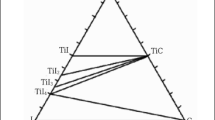The interaction of chromium oxide with different forms of carbon in a wide temperature range is investigated. The phase composition and morphology of the resulting powder product are examined. It is established that Cr3C2 and Cr7C3 single-phase chromium carbide is formed at 1400 and 1500°C, respectively. It is shown that the smallest particle size (0.85 μm) is due to the mixed structural state of Cr7C3 and Cr3C2 carbides.

Similar content being viewed by others
References
Z. Zhao, H. Zheng, Y. Wang, et al., “Synthesis of chromium carbide (Cr3C2) nanopowders by the carbonization of the precursor,” Int. J. Ref. Met. Hard Mater., 29, No. 5, 614–617 (2011).
R. E. Kahrizsangi, H. M. Zadeh, and V. Nemati, “Synthesis of chromium carbide by reduction of chromium oxide with methane,” Int. J. Ref. Met. Hard Mater., 28, No. 3, 412–415 (2010).
A. Nikitin, Y. Gogotsi, and H. S. Nalwa, “Nanostructured Carbide-Derived Carbon”: in: Encyclopedia of Nanoscience and Nanotechnology. Vol. 7, American Scientific Publishers, CA (2004), pp. 553–574.
S. Loubiere, Ch. Laurent, J. P. Bonino, and A. Rousset, “Microstructure and reactivity of Cr3C2 powders of different morphology,” Mater. Res. Bull., 30, No. 12, 1535–1546 (1995).
Hao-Tung Lin, Sheng-Chang Wang, Jow-Lay Huang, Shin-Yun Chang, “Processing of hot pressed Al2O3–Cr2O3/Cr-carbide nanocomposite prepared by MOCVD in fluidized bed,” J. Eur. Ceram. Soc., 27, No. 16, 4759–4765 (2007).
I. G. Chernysh, I. I. Karpov, G. P. Prikhod’ko, and V. M. Shai, Physical–Chemical Properties of Graphite and Its Compounds [in Russian], Nauk. Dumka, Kiev (1990), p. 199.
R. Kiffer and P. Shwartskopf, Hard Alloys [in Russian], Metallurgizdat, Moscow (1957), p. 664.
G. V. Samsonov and Ya. S. Umanskii, Hard Compounds of Refractory Metals [in Russian], Metallurgizdat, Moscow (1957), p. 388.
R. Berkane, J. C. Gachon, J. Charles, and J. Hortz, “A thermodynamic study of the chromium–carbon system,” CALPHAD, 11, No. 2, 152–159 (1987).
E. A. Levashov, A. S. Rogachev, V. I. Yukhvid, and I. P. Borovinskaya, Physical-Chemical and Process Fundamentals of Self-Propagating High-Temperature Synthesis [in Russian], BINOM, Moscow (1999), p. 176.
Author information
Authors and Affiliations
Corresponding author
Additional information
Translated from Poroshkovaya Metallurgiya, Vol. 56, Nos. 9–10 (517), pp. 34–39, 2017.
Rights and permissions
About this article
Cite this article
Pinchuk, N.A., Gadzyra, M.P. & Hnylytsia, I.D. Features of Chromium Carbide Synthesis Using Different Forms of Carbon. Powder Metall Met Ceram 56, 512–515 (2018). https://doi.org/10.1007/s11106-018-9923-y
Received:
Published:
Issue Date:
DOI: https://doi.org/10.1007/s11106-018-9923-y



